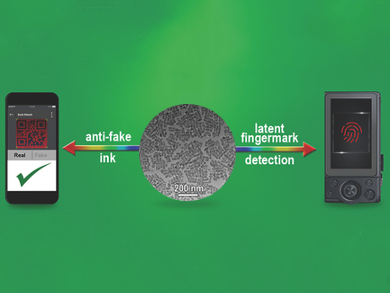Anticounterfeiting technology can be fairly complex. Fluorescent inks, in contrast, are usually easy to use and cost-effective. Fluorescent materials can also be used to develop latent fingerprints for forensic applications.
Chunguang Li, Zhan Shi, Jilin University, Changchun, China, and colleagues have synthesized lanthanide-doped LaVO4 nanoparticles (NPs), which can be used both in anti-forgery inks and for fingerprint detection. The team used a microwave reactor system to prepare the nanoparticles from mixtures of lanthanide chlorides (LaCl3, EuCl3, or DyCl3), polyacrylic acid (PAA) as a surfactant, and Na3VO4·12 H2O in aqueous solution.
The prepared nanoparticles are crystalline and have an average size of 43 nm. They have excellent fluorescence properties under ultraviolet light (UV) excitation. The europium-doped NPs have a bright red fluorescence, and the dysprosium-doped NPs glow almost white under UV light. The team used an aqueous solution of the nanoparticles as a fluorescent ink to print anti-forgery patterns, which can be captured and verified using a smartphone camera. In addition, the synthesized nanoparticles can be applied to surfaces in powdered form with a brush to develop latent fingerprints, which can then be photographed under UV light excitation.
- Facile Synthesis of Highly Water-Soluble Lanthanide-Doped t-LaVO4 NPs for Antifake Ink and Latent Fingermark Detection,
Cailing Chen, Ying Yu, Chunguang Li, Dan Liu, He Huang, Chen Liang, Yue Lou, Yu Han, Zhan Shi, Shouhua Feng,
Small 2017.
DOI: 10.1002/smll.201702305




